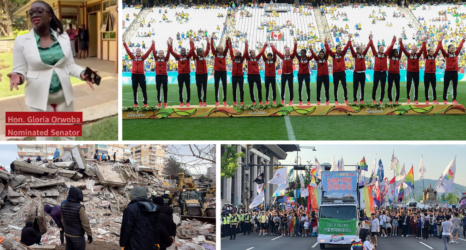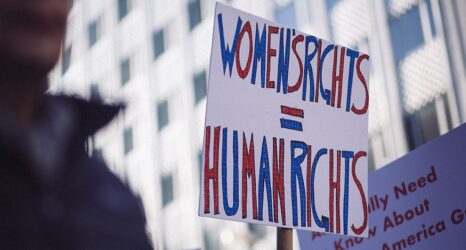Since raising expectations of an ambitious international agenda, Justin Trudeau and his team have worked hard to cultivate the image of a modern, progressive government, led by a young and hip prime minister who attracts positive international attention, holds his own on the world stage and says (and wears) the right thing.
Yet more than 18 months into its mandate, the Trudeau government has not gone beyond platitudes to fully articulate a vision for Canada’s engagement in the world beyond “Save Nafta” and “Canada on the Security Council 2021.”
Although the foundation of foreign policy has always been the protection of national interests, governments can define those interests in narrow or broad terms. The current global environment is challenging and unpredictable, and caution is critical to protect the social and economic wellbeing of Canadians. But driven by a domestic focus, the Trudeau government’s forays on the world stage have an almost narcissistic quality. Evidence? Trudeau’s November trip to Liberia, one of the world’s poorest countries, where he announced $1 million to help Liberia hold elections but not a penny to strengthen its post-Ebola health system, provide education services or support the country’s economy (though the government also pledged a contribution to UN Women’s regional programs). But the trip provided a wonderful photo opportunity for Trudeau to pose with an African icon, President Ellen Johnson Sirleaf.
There are some hints in Ottawa that this lack of focus is starting to change, with a recent emphasis on an explicit feminist foreign policy agenda, as the government’s $650 million pledge back in March toward health programs for women previewed.
Applying a feminist lens to Canada’s foreign policy engagement makes good sense. The evidence is clear: gender equitable societies are more peaceful and more prosperous. They are better places for everyone to live. Such a strategy could anchor our engagement in the world. But despite indications that this strategy is a priority for the government, neither its critics nor the government itself have reflected on what we can learn from decades of slow progress on gender equity and what is needed to make such a strategy truly meaningful for women and girls around the world.
Canada has been attempting to empower women and girls for a long time. The first global conference on women was held in Mexico in 1975. The International Conference on Population and Development (along with the UN commission by the same name) was established in 1994. The landmark Beijing Conference on Women that resulted in the Beijing Platform of Action was held in 1995. The UN Security Council passed its critically important resolution on Women, Peace and Security 1325 in 2000, with its main messages affirmed in multiple follow-up resolutions. The third Millennium Development Goal focused on gender equality and empowerment of women, while the follow-up fifth Sustainable Development Goal commits to achieving gender equality and empowering women and girls.
Canada has worked within its foreign and development ministries to advance these goals through its foreign policy. And Canada’s engagement has contributed to meaningful global progress on some indicators: low-income countries met the Millennium Development Goals on girls’ attendance in primary school; the number of women in parliaments worldwide doubled; maternal mortality fell by almost 45 percent; and access to birth attendants increased by almost 60 percent.
Yet other indicators lag behind. Although girls attend school, in many contexts their learning scores remain low. Early marriage and early pregnancy continue at high rates, even increasing in places such as conflict-affected Syria. Fertility rates remain stubbornly high in Sub-Saharan Africa, meaning most countries in the region do not experience a ‘demographic dividend’ and women face a punishing dependency burden. HIV rates among adolescent girls are often double or triple that of their male counterparts. Violence against women continues at high levels in some parts of the world, with shocking evidence of widespread and systematic sexual violence and exploitation in current conflicts in Syria, Yemen and South Sudan.
What does this lack of progress mean, considering the decades of work on the issue? Many development practitioners would argue that it means more money should be directed towards empowerment for women and girls. (Lauren Dobson-Hughes rightfully explained on this sitewhy the recent federal budget was sorely lacking in this area.) True, but money isn’t everything. Others argue that it demonstrates the challenge and critical importance of a clear focus on gender equity through all aspects of our foreign policy engagement. True again.
But what really makes a society gender equitable? And how do societies transform?
Gender equity means that girls and women have full control over their reproduction and sexuality; equal access to quality education that gives them skills to engage in society and compete in the economy; equitable access to employment and livelihood opportunities, including property rights, access to credit and employment benefits; and, equitable access to social services, including quality health care, with recognition of the reproductive role of women.
For societies to support these attributes of gender equity, they require formal laws that recognize, protect and promote women and girls in public institutions, the private sector, and their personal spaces. They also need public institutions that can deliver social services and provide social protection, as well as political parties and civil society groups that promote the engagement and involvement of women and girls. And they need a supporting context of sustainable economic growth.
But gender equity needs something else. And it is less tangible.
Formal political and economic institutions and laws are embedded and shaped by social and cultural beliefs about the role of men, women, girls and boys—how they should behave, how they should not behave, what life opportunities they should be afforded, and how they can and should be treated.
In many lower income settings these social and cultural beliefs view women and girls as objects to dominate, limiting their life chances. The same beliefs shape the behavior of men and boys—resulting in more violent, risk taking behavior. These beliefs are harmful for everyone.
So in answer to the question about what makes a society gender equitable, and how to help societies transform, a bricks and mortar analogy is helpful. The bricks of a gender equitable society are laws and formal institutions and services. Canada should continue to help countries supply the “bricks” by strengthening social services like health and education, supporting progressive legal frameworks, and encouraging women’s representation in politics and the economy. But what makes these initiatives successful is the mortar — the beliefs held by society about women, girls, men and boys. These beliefs facilitate or undermine the objective of gender equity. Meaningful progress on adolescent HIV rates, maternal mortality, or women in the workplace cannot be made without tackling attitudes and beliefs about gender held by both women and men.
To be the right tool to help transform societies to become gender equitable, a feminist foreign policy must therefore address both the bricks and the mortar. The Trudeau government has to go beyond tough talk on gender in the easy places—Ottawa, New York and Geneva. It needs to better integrate gender equity into Canada’s objectives in our diplomatic engagement, including in the difficult places—those countries where the lack of both the bricks and mortar of gender equity prevent women and girls from advancing.
Emerging evidence from diverse cases shows that stubborn beliefs about gender can change. Yet any effort to transform attitudes about gender must be led from within. Outsiders like Canada can provide the funds, the tools and skills training for national actors, but the evidence is also very clear that these efforts must integrate a reflection of the role of men and boys, their socio-economic context, how beliefs about masculinity can result in harmful risk taking behaviours, and how gender equity would positively affect their lives.
Drivers of change include radio and TV dramas that enable individuals and communities to use the experiences of fictional characters to confront and transform beliefs about gender. A recent World Bank assessment of MTV Shuga, filmed in Nigeria and broadcast in 70 countries, found that within the study group of people that watched the show, individuals experienced a discernible decrease in domestic violence and partner rape. Technology is also a key tool to enable women and girls to help themselves. Political, religious and civil society leaders and their advocacy can make a big difference in some places. And economic opportunities are also critically important.
These drivers of change are diverse, and often come together to challenge and transform gender norms in ways that are unpredictable and not always measurable. Moreover, this process is very political. When working with national organizations, Canada needs to be aware of what groups our interventions empower, what groups they disempower, and how this process impacts on broader political, social and economic dynamics within society.
So it is not a straightforward path for outsiders—such as Canada—to help build both the bricks and mortar of gender equity in other countries. But it can be done.
To fulfill a feminist foreign policy agenda, we need more than the words of politicians like Trudeau and International Development Minister Marie-Claude Bibeau. And we must go beyond simply counting the number of women in cabinet, senior levels of the bureaucracy, and among Canada’s diplomatic representatives.
A feminist approach to foreign policy shouldn’t be about us—it needs to promote a meaningful and comprehensive contribution to gender equity through all components of our diplomatic engagement. To undertake this engagement Canada’s public servants, both female and male, need to be analytically strong and intellectually curious, and have a desire to know the what—not just the how—of foreign and development policy.
Our diplomats are the face and voice of Canada in the “difficult places.” Senior officials must be empowered to go beyond ‘listening’ tours of Africa and other regions—where they say little but write big cheques to multilateral organizations—and undertake ‘learning’ tours. Briefings with national stakeholders, the World Bank, multilateral agencies, and other donors should be opportunities to better understand the socio-economic situation for women and girls. Moreover, Canada should not be afraid to raise sensitive issues, such as early marriage or domestic and sexual violence. Silence in the face of such abuses of human rights is cowardice. Canadian representatives abroad have no reason to be fearful — but the women and girls facing abuse do, and they need advocates. So it is important that Canadian diplomats know the details of the gender dynamics of their countries and regions of responsibility. Because if public servants who develop and oversee these programs do not know the “what”—the political, social, economic and cultural dynamics that drive gender inequities—undertaking the “how” of feminist foreign policy will be showmanship, not substance.
A feminist foreign policy could provide a constructive focus for Canada’s international engagement. The effort to promote gender equity is really about trying to facilitate more compassionate, inclusive and fair societies where the rights of everyone are respected. In today’s challenging and complex world, any effort by Canada to promote rights and equity may nudge the broader international community to focus on what makes us all human.
And if it brings Trudeau some great photo ops, so be it—we can buy him some pink socks.
Originally published at OpenCanada. Republished with permission.





